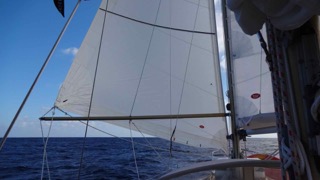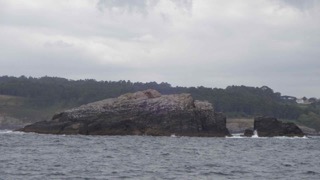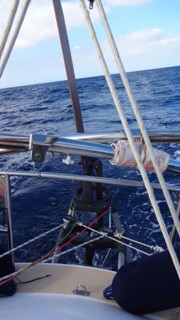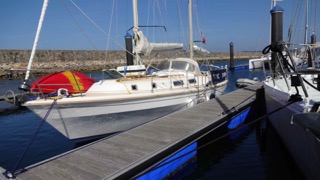43 25.450N 008 14.187W

|
Date: Thursday
9th July 2015 Position: Ría de Ares Before I carry on any further I must amend an error in my previous blog
just in case some of you think that I am a freak with hands the size of a prize
watermelon. When I said the cut on my
hand was twenty centimetres long I did, of course, mean twenty millimetres (two
centimetres). For the sake of accuracy
I have measured the scar and it is actually twenty-three millimetres, but
whatever the length it is healing up nicely. Why did we ever have to go metric? I mean, you can’t even get a pint out here;
they serve your beer in small glasses although I have noticed that if you ask
for a beer and the barman/woman realizes you’re English they immediately ask if
you want a “Grande”. We Brits do have a bit of a reputation abroad and having
the likes of Bobby Prentice owning a villa in Spain doesn’t help out. I am sure he must keep Catties (his local)
afloat all on his own, although I did help him out as best I could on the last
occasion that Ann and I joined him and Irene at their villa. Now, where did I leave you, oh yes, half way across the Bay of Biscay,
contemplating what to have for supper?
The Thai pork curry won the day and there was even enough left over to
feed the fishes. As Ann would say “my
usual army portions”. Well, you can take the boy out of the Army, but you can’t
take the Army out of the boy. For the most part my second night at sea was
made under sail. Being further from land
the commercial traffic was much less but there where still a few boats around. As part of my refit I installed a “B Class” AIS
(Automatic Identification System), which is invaluable and in some respects
better than radar, which I also have. In respect of AIS leisure sailors have two options. Firstly, the basic system receives information
only and the second, the “B Class”, transmits your information as well. I shall
explain. Any vessel over a certain tonnage, three hundred tons I think, is
required by maritime law to constantly send out a radio signal detailing the
name of the ship, course, speed, MMSI number (a kind of phone number for VHF
radio stations so you can call the bridge direct instead of using channel 16,
which is reserved for emergency radio traffic) and their call sign. If you have an AIS system on board your boat
it will pick up the radio transmission and show this information as an icon on
your chart plotter using an elongated triangle with a small point in the far
corner indicating the direction of travel.
If you put the cursor of your chart plotter on the icon all of the above
information will be displayed. The radio
transmissions can be picked up miles away.
For example, if I am anchored in Pool harbour I can pick up the
commercial traffic in the shipping lanes across the Channel fifty miles away. For leisure sailors the best bit of
information the AIS will give you is the CPA (closest point of approach) of the
vessel you have selected and the time to CPA in respect of your own position,
which is really helpful. You can also
set up alarms for the CPA and the TTCPA, which is very good but which can also
be extremely irritating if the alarm keeps going off every few seconds, which
it does. But, presented with both these
sets of information if a situation develops and you are concerned about the
risk of a collision with another vessel you can monitor the AIS and make an
informed decision whether to continue to stand on your course or change. You can even call the officer of the watch on
the vessel concerned to discuss options.
I know the system works because I was caught off guard slightly that
night. A station was called “Celtic Dawn”
on VHF channel 16. I didn’t react at
first because the person calling from the other station had a strong accent
that made it difficult to make out who they were calling. Secondly this had only been the second time
in seventeen years of sailing that another station has called me directly on
VHF. The call came over the VHF again
and when I did get my act together I called back on channel 16, “station
calling Celtic Dawn this is Celtic Dawn on channel 16 over”. I heard nothing so tried again but again
nothing was fourth coming. I looked at
my chart plotter and worked out that he vessel calling me was a fishing vessel.
They must have just shot their nets and
were concerned about our respective courses.
However, there did not seem a risk of a collision so I assume this was
why the vessel did not responded when I called back. At least I now know that the system works. As I mentioned, AIS is a legal requirement for
boats over three hundred tons but for anything under that there is no
requirement. Many yachts just have the
basic AIS system that receives these radio transmissions, which is really all
that is required. Before I had AIS
crossing the shipping lanes in the Channel could be a bit of a bum
clencher. Quite often I would change
course when there was no need to but with the advent of AIS skippers of small
yachts can be much more positive in their decision making. However, for the journey I was planning, I
wanted to be able to transmit my own information especially when further away
from shore in the open ocean. That is
why I elected to go for the B Class AIS, which was a little more expensive, but
worth the extra money for peace of mind.
When close to land in busy areas, for example, the Solent, I can turn
the signal off so as not to clutter up radio traffic. Imagine the Solent on a bank holiday weekend
with every small yacht sending out an AIS transmission, it would be
mayhem. On the other hand deeper out to
sea sending out your own signal could be a lifesaver. Of course AIS has its limits the most
obvious of which is that not all vessels are required to have it it. Therefore, keeping a good watch for smaller
vessels is still an essential requirement and this is where my second backup comes
in, radar. I also have radar aboard
Celtic Dawn, which is a basic system but works just fine for picking up the smaller
vessels missed by AIS. Between Radar and
AIS I think I am well covered. That
said, there is still no substitute for a good pair of eyes but even these get
tired sometimes especially on solo sailors. I managed to get a bit more sleep than the night before but did wake
every half an hour to have a good look over the horizon for any vessels not
picked up by the AIS. Towards morning
the wind began to drop and with it my speed.
Eventually my speed dropped below 2.5 knots and so the engine went into
action once again and I motor sailed for most of the morning. At around 11 am the wind was back and I was
under sail again. The wind still had too
much south in it for my liking but I was making progress close hauled at a
respectable 4.5 – 5 knots. Bilge keel
boats like Celtic Dawn are not great when sailing on a point close to wind as
opposed to fin keel boats that can make better ground in the same
conditions. But luckily the wind shifted
a little and I was able to free off 6° and my speed went up to average 6 – 6.5
knots, we were now cracking along. The
wind continued to shift until it came astern of me so I decided to set up a
“goose wing” rig and come onto a run. A
“goose wing” rig is very simple rig used for sailing down wind sailing. You basically pole out the genoa so that as
much sail area as possible is presented to the wind and then set the mainsail
on the opposite side so it too presents as much sail area to the wind. To “pole out” the genoa you use the spinnaker
pole and rig uphaul and dawnhaul lines to keep
the pole level. Then you attached a “guy
line” to the genoa, come onto the course required to keep the genoa filled and pull
in the “guy line” to set the genoa on the port or starboard side which ever you
have selected. The most important line
to rig is the “preventer” which is attached to the end of the boom and led forward
of the mast. Once the mainsail is pushed
as far forward as it will go on the opposite side of the genoa the “preventer”
is pulled tight and made fast. This
prevents the possibility of an accidental gibe should the wind get behind the
sail. Accidental gibes can cause an
enormous amount of damage and can even kill a person if not careful. Ann and I found out the hard way. We were sailing back from Plymouth to
Dartmouth some years ago with the wind behind us “goose winged” as describe
above. The problem with sailing down
wind is that it can lead you into a false sense of security because you do not
feel the full effect of the wind behind you unless you constantly monitor the situation. To explain what I mean, imagine you were out
jogging say at 6 mph and the wind was in front of you and was also blowing at 6
mph, the effect you feel on your body would be 12 mph, your speed and the wind
speed combined. Now, turn the other way and
run with the wind on your back and you would feel nothing as your speed cancels
out the wind speed because you are running with it. And so it is on a yacht, as the speed of the
wind increased behind you, you do not always notice or should I say appreciate
the reality of the situation because you’re having a bloody good sail. It is not until you look down at your instruments
and you realise there are 20 knots of wind behind you and you should have
reefed down ages ago. This was the
situation Ann and I found ourselves in as we rounded Start Point. I tried
desperately to get the genoa reefed but the wind was already too strong. The “guy line” to the genoa was stuck on the
end of the pole and would not budge which meant I could not furl the
genoa. In the end the wind pressure on
the sail was so great that I let go of the line and the sail flew forward. There was now no other option but to go
forward and untangle the lines and furl the genoa by hand leaving Ann on the
helm. Now Ann will admit herself that she
finds helming a boat difficult especially in such conditions. So, I am on the foredeck fighting to get the
genoa under control, Ann is on the helm struggling to keep on course and rather
stupidly, I had removed the preventer from the boom before going on deck. I felt the boat going off course and
immediately knew she was about to do a gibe.
I shouted back at Ann waving my hands to indicate that she should duck
down, but the more I waived my hands the more she stood up saying “what”? Just
in time she got the message and ducked as the boom flew 180° from one side of
the boat to the other with an almighty crash.
It completely shattered the goose-neck, the cast iron fitting that
attaches the boom to the mast, so imagine the damage such power would have
caused if the boom had hit Ann on the head.
Some may say it might have knocked some sense into her but I couldn’t
possibly comment. Ever since, when I am running before the wind I keep a very close eye on
the situation. As forecast, late that
afternoon the wind had increased to an average of 15 knots so I decided to put
a reef in the genoa but left the main sail as she was. We were now doing an average of 7.5
knots. I prepared myself for the night watch
knowing that because I was now closing La Coruna there would be little time to
sleep because of the likelihood of an increase in commercial traffic. Throughout the night the wind kept
increasing until it was averaging 25 knots gusting 30 knots, a near gale as
predicted. By this time I had furled the
genoa completely and was sailing under full mainsail only. Under the conditions I would like to have had
a reef in the mainsail but Celtic Dawn was copping well, Henry was keeping us
on course nicely and we were still making good way at 6.5 knots. So I decided to keeps thinks as they were and
wait for more sheltered conditions before making any changes. In someways it was good to be sailing in the
dark because I couldn’t see the waves coming in. The occasional larger wave would hit the
stern knocking us off course and Henry would struggle for a moment or two but
he always came through with the goods and got us back on track. My theory about the commercial traffic was
correct and the closer I got to La Coruna the busier it became. At a guess I
would say they were virtually all fishing boats, there must have been two dozen
or more in the space of three hours, all coming from La Coruna. After a little dodging this way and that I
was soon in Ría Crouna. It was still
dark and not knowing the area I wanted to make it simple, so rather than making
for one of the marinas I decided to anchor instead and made for Ría de Ares a
little further on. Anyway a day or two
at anchor would save me a bit of money and be a welcome break from marina life. I arrived at Ría de Ares an hour later, 7 am,
but before turning in for a well earned rest I had breakfast and a couple of
large G&T’s. Now, I know what you
are thinking, G&T for breakfast? But
before passing judgement remember this, I had just crossed the Bay of Biscay
solo so quite rightly I was a bit chuffed with myself and felt a celebration was
in order. If you read any of the pilot
books about doing an Atlantic circuit they all virtually say that the most
difficult part of the adventure is crossing the Bay of Biscay. Certainly, insurance companies think so
because they put so many restrictions in their policies regarding this area, which
is why, as a solo sailor, I could not get insured. So “boo hoo” to you Navigators and General,
I’ve done it and it didn’t cost me £1,000 for the privilege. So forgive me for being a bit smug over the
next few days but I feel I have achieved something today. Don’t worry, I’ll be brought down to earth
soon enough, the sea has a way of slapping you in the face saying, “so you
think you’re a sailor now do you sonny, well take this then”. Anyway, I am off the get some rest now and will catch up with you later. Bye for now. Signing off Ted   The Goose wing Rig. Note the up-haul and Oops! mind the rocks. On my approach to La Coruna. dawn-haul lines keeping the pole in place   Henry doing his thing Celtic Dawn moored in La Coruna Marina. More about that later
|